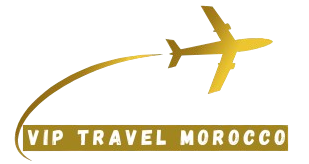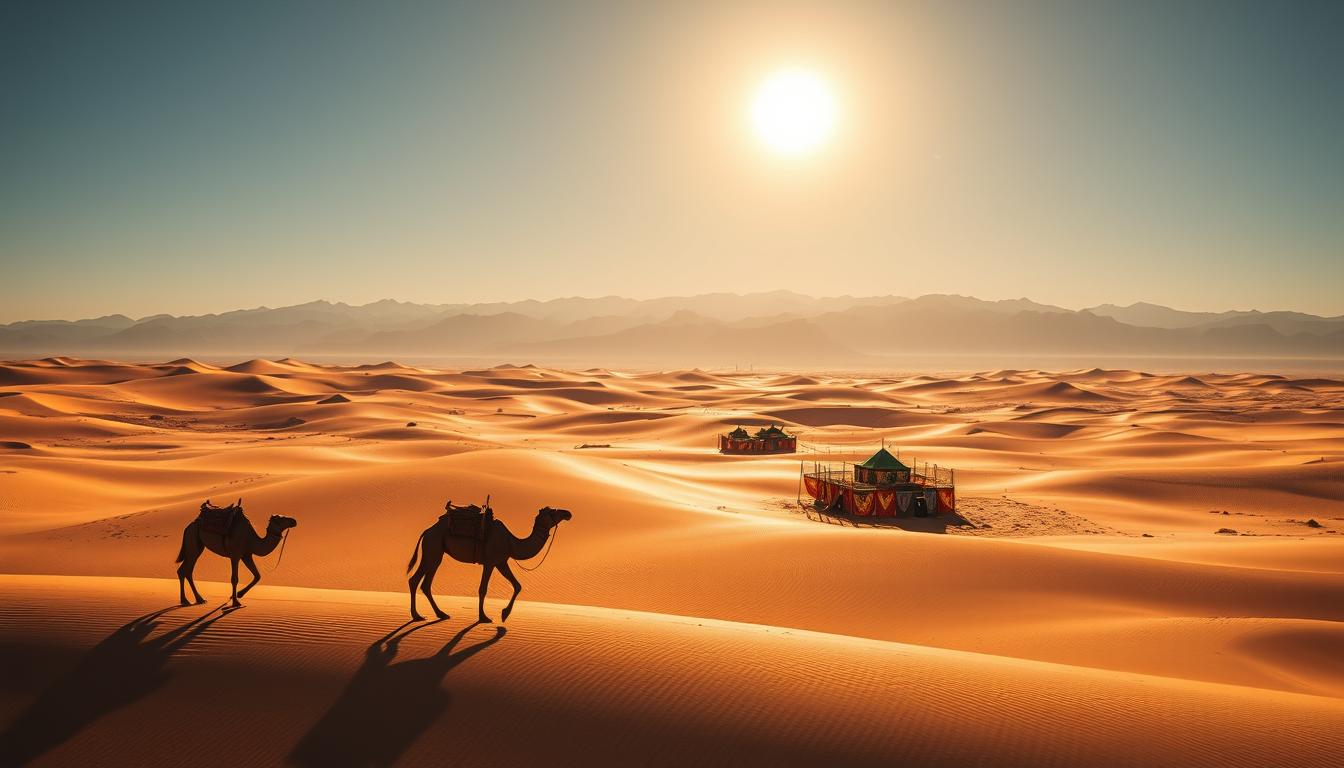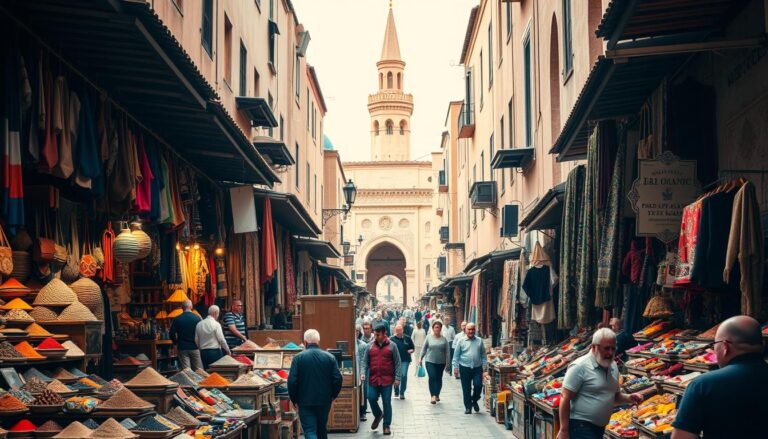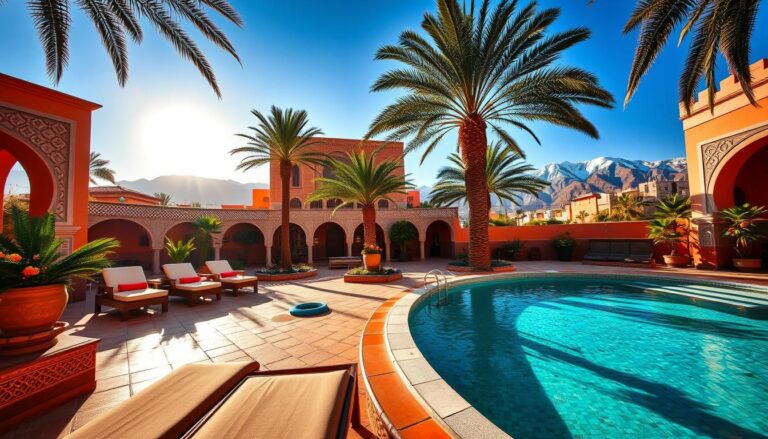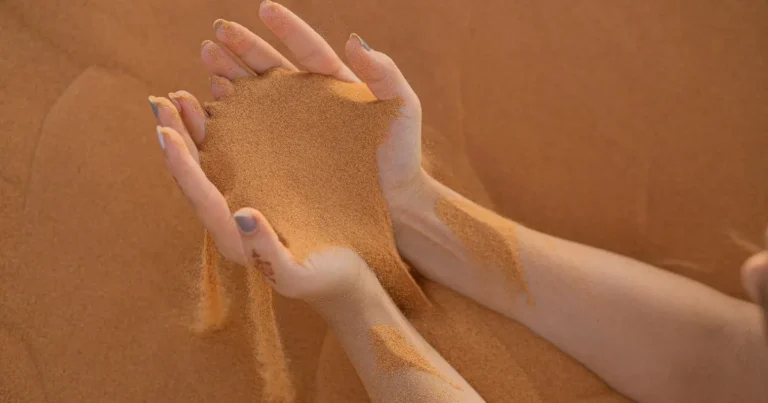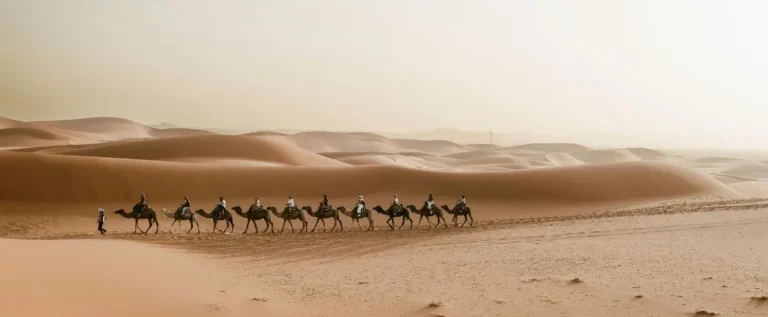Marrakech to Sahara Desert Tours | Experience Morocco
The first time I saw the Sahara’s endless golden sands, I knew why people dream of this trip. Morocco’s desert is more than a place—it’s a journey that awakens your spirit of adventure.
The Sahara stretches far and wide, showing more than just its size. Your trip to the desert promises to immerse you in ancient landscapes, rich cultures, and stunning beauty.
From Marrakech’s lively streets to Erg Chebbi’s calm dunes, this journey offers a unique view of Morocco. Every mile shows different scenes: busy cities, tall mountains, and the vast desert.
Whether you’re an experienced traveler or new to adventures, this marrakech to sahara desert tours will create unforgettable memories. Get ready to be amazed by a landscape that has inspired many for centuries.
Table of Contents
Planning Your Desert Adventure
Planning a trip for marrakech to sahara desert tours needs careful thought. You want to make sure your Sahara adventure is memorable. It should mix comfort, excitement, and learning about local culture.
A 3-day marrakech to sahara desert tours is ideal for those wanting a real desert adventure. With the right prep, your trip can become an amazing journey.
Best Time to Visit the Sahara
Choosing the best time for your desert trip is key. The Sahara’s weather changes a lot each year:
- Spring (March-May): Mild temperatures and little rain
- Autumn (September-November): Nice daytime weather
- Winter (December-February): Cool days, cold nights
- Summer (June-August): Very hot, hard conditions
What to Pack for Desert Travel
Packing right is essential for a great Merzouga desert trip. You’ll need:
- Light, loose clothes
- High-SPF sunscreen
- Wide-brimmed hat
- Comfortable shoes for walking
- Light jacket for cool evenings
Tour Duration Options
| Tour Length | Highlights | Recommended For |
|---|---|---|
| 2-Day Tour | Quick desert glimpse | Time-constrained travelers |
| 3-Day Sahara Tour | Comprehensive experience | Most popular option |
| 4-5 Day Tour | In-depth exploration | Adventure enthusiasts |
“The desert is a natural extension of the inner silence of the body.” – Jean Baudrillard
Pro tip: A 3-day Sahara tour from marrakech to Merzouga is the best mix. It lets you see Erg Chebbi’s beauty without rushing.
Marrakech to Sahara Desert Tour: Essential Guide
Planning a trip to the Moroccan Sahara needs careful thought. The journey from Fes to Marrakech is a stunning adventure. It takes you through different landscapes and cultural spots.
Your desert trip will take you through beautiful areas. You’ll see the Sahara Desert and major Moroccan cities. Knowing the route, how to get there, and booking tips will make your trip memorable.
Route Overview
The trip is about 500 kilometers long. It goes through several areas:
- Marrakech to High Atlas Mountains
- Crossing Tizi n’Tichka mountain pass
- Passing through Ouarzazate
- Arriving at Merzouga desert gateway
Transportation Methods
There are many ways to travel to the Sahara:
| Transportation Type | Cost Range | Comfort Level |
|---|---|---|
| Shared Minivan | $70-$150 | Budget-friendly |
| Private 4×4 | $250-$500 | Comfortable, flexible |
| Organized Tour | $300-$700 | All-inclusive |
Booking Options and Costs
When planning your trip, think about these booking tips:
- Online advance booking for guaranteed spots
- Local agency bookings in Morocco
- Hostel/hotel tour desk reservations
“The magic of the Moroccan Sahara begins long before you reach the desert.” – Moroccan Travel Proverb
Prices vary from $70 to $700 per person. Booking early can get you better rates and ensure spots during busy times.
Atlas Mountains and Scenic Stops
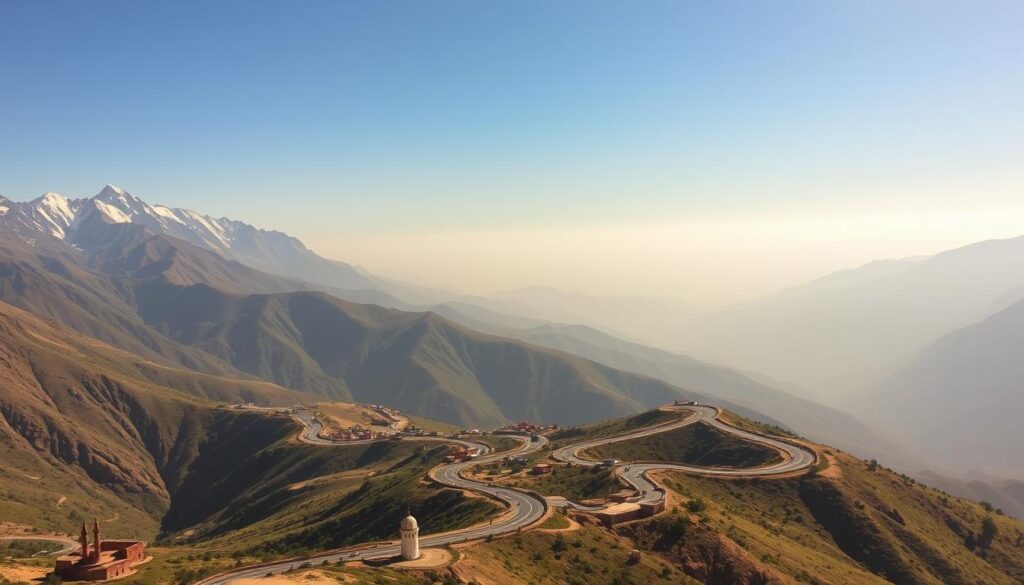
Your trip from Marrakech to the Sahara Desert goes through the Atlas Mountains. This area is breathtaking and unforgettable. It shows Morocco’s amazing variety of landscapes.
Driving through the mountains, you’ll see incredible views. The Tizi-n-Tichka pass, at 2,260 meters, has some of the best views in Morocco.
- Dramatic mountain scenery with snow-capped peaks
- Traditional Berber villages nestled in mountain valleys
- Stunning panoramic viewpoints along the route
- Unique geological formations and rocky landscapes
On your journey, you’ll find hidden treasures. Small Berber villages show you their culture. The contrast between green mountains and dry plains is truly beautiful.
“The Atlas Mountains are nature’s grand transition between civilization and wilderness” – Moroccan Travel Guide
Photographers and nature lovers will love this place. Every turn offers a new view. It makes the mountain crossing a key part of your Moroccan trip.
Exploring Ait Ben Haddou UNESCO Site
As you travel through Morocco’s beautiful landscapes, Ait Ben Haddou is a must-see. This ancient village is a gem of architecture and culture. It’s a place where time seems to stand still.
Historical Significance
Ait Ben Haddou sits on old trade paths. It’s a prime example of Moroccan clay architecture. The UNESCO site shows how Berber people built their homes:
- They used mud-bricks for centuries.
- The village was built to keep traders and locals safe.
- It was a key spot for cultural exchange.
Photography Opportunities
Photographers will love Ait Ben Haddou. The kasbah is full of:
- Beautiful mud-brick buildings.
- Views of the desert that take your breath away.
- Perfect light for amazing photos.
Hollywood’s Desert Gem
Visiting Ait Ben Haddou makes your desert camp trip even more special. It’s been in many famous movies. Game of Thrones fans will recognize it, and movie lovers will remember it from Gladiator and Lawrence of Arabia.
A living museum that bridges ancient traditions with cinematic storytelling
Dades Valley and Todra Gorge Experience
Your morocco desert trip hits a high point when you see the Dades Valley and Todra Gorge. These spots are natural wonders that take you on a memorable trip through Morocco’s dramatic views. They show off unique geological and rock formations.
The Dades Valley is called the “Valley of a Thousand Kasbahs”. It has amazing rock formations called “Monkey Fingers”. These formations make a surreal landscape that amazes photographers and nature lovers on their morocco desert trip.
“The landscape here speaks a language older than words, carved by wind and time.” – Moroccan Travel Proverb
Todra Gorge is another must-see with its limestone cliffs over 300 meters tall. It’s perfect for rock climbing and hiking, with many trails and tough routes.
- Stunning rock formations in Dades Valley
- Photography opportunities at Todra Gorge
- Short hiking trails for adventure seekers
- Interactions with local Berber communities
When you visit, be ready for some walking and wear comfy shoes. Don’t forget water and a camera to capture the stunning views of your morocco desert trip.
Merzouga and Erg Chebbi Dunes
Merzouga is at the heart of the Sahara, leading to the stunning Erg Chebbi dunes. Your journey starts with an exciting trip to one of the most amazing landscapes. The golden sand mountains tower over the desert, making for a unique Moroccan adventure.
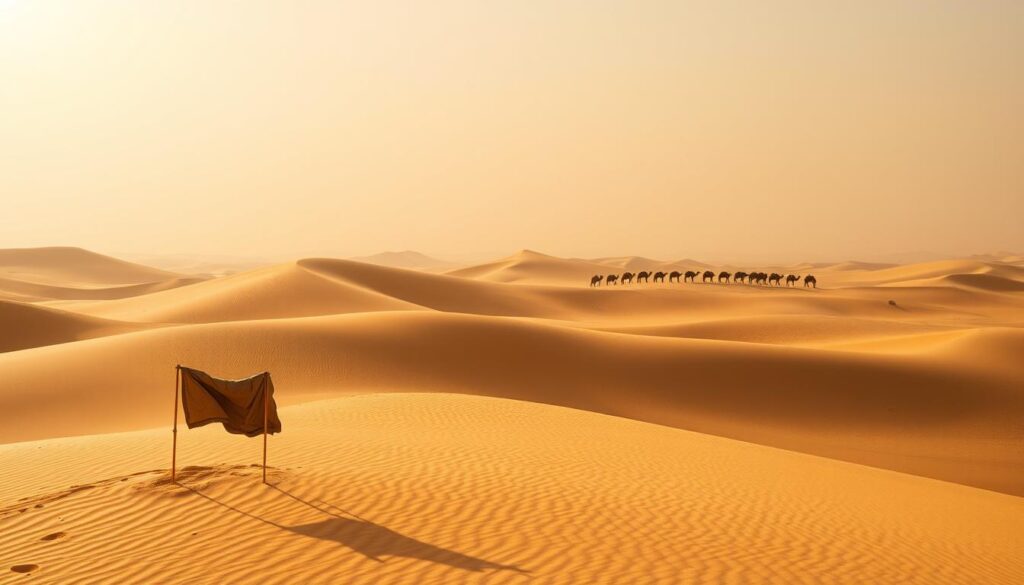
Camel Trek Adventures
Exploring the Sahara on camelback connects you with Morocco’s nomadic traditions. Your adventure includes:
- Guided camel rides lasting about 1-2 hours
- Experienced local Berber guides
- Stunning panoramic desert views
- Opportunity to learn about desert ecosystem
Desert Camp Facilities
Your stay ranges from simple tents to luxury glamping. You’ll find:
- Comfortable sleeping arrangements
- Traditional Berber-style dining areas
- Basic bathroom facilities
- Communal gathering spaces
Sunset and Sunrise Views
The most magical moments are during sunrise and sunset. The Erg Chebbi dunes turn into a colorful canvas. Golden sands change to deep orange and soft pink. These views are a treat for photographers and nature lovers.
“The desert is a natural wonder that speaks to the soul, revealing beauty in its most raw and untouched form.” – Moroccan Traveler’s Insight
Traditional Berber Culture and Music
Your moroccan sahara experience isn’t complete without diving into the rich cultural tapestry of the Berber people. These indigenous inhabitants of North Africa have thrived in the challenging desert environment for thousands of years. They have developed a unique and resilient culture that continues to captivate travelers.
Berber music stands as a powerful expression of their heritage. During desert camp evenings, you’ll encounter traditional performances that transport you to another world. The rhythmic sounds of instruments like the gimbri (a three-stringed lute) and bendir (a frame drum) create an enchanting soundtrack to your moroccan sahara experience.
- Traditional musical instruments include gimbri, bendir, and wooden flutes
- Performances often occur around campfires under starlit desert skies
- Songs typically tell stories of desert life, love, and ancestral traditions
The Berber culture goes beyond music, encompassing intricate handicrafts, distinctive clothing, and time-honored survival techniques. Their clothing, typically made from wool and decorated with vibrant patterns, reflects both practical needs and artistic expression in the harsh desert landscape.
| Cultural Element | Description |
|---|---|
| Language | Amazigh (Berber language) |
| Traditional Clothing | Wool djellaba, colorful woven textiles |
| Main Occupations | Herding, agriculture, handicrafts |
When you join a desert tour, you’ll have opportunities to interact with local Berber communities. You’ll learn about their remarkable adaptation to one of the world’s most challenging environments. Their hospitality and deep connection to the desert will undoubtedly be a highlight of your moroccan sahara experience.
Luxury vs Budget Desert Camping
Planning an overnight desert luxury camp offers many options for different budgets and comfort levels. You can choose from simple experiences to luxurious glamping. This way, your Sahara Desert adventure can be just what you want.
There’s a wide range of desert camping experiences. The right one depends on your comfort, budget, and what you need.
Accommodation Types
Desert camping has many choices:
- Basic Tents: Shared facilities, minimal amenities
- Standard Camps: Private tents with basic sleeping arrangements
- Luxury Glamping: Full-service tents with modern conveniences
Amenities Comparison
The amenities at an overnight desert camp greatly affect your stay. Budget options usually have:
- Shared bathroom facilities
- Basic mattresses or sleeping mats
- Communal dining areas
Luxury camps offer more with:
- Private en-suite bathrooms
- Comfortable beds with quality linens
- Electricity and charging stations
- Gourmet meal services
Price Ranges
Prices for an overnight desert camp vary by amenities and location. Expect to pay:
- Budget camps: $30-$60 per person
- Mid-range camps: $60-$150 per person
- Luxury glamping: $150-$300 per person
Pick an overnight desert camp that fits your budget and comfort needs for a memorable Sahara trip.
Desert Photography and Stargazing
Your trip to the erg chebbi dunes is a dream for photographers and stargazers. The Sahara Desert turns into a stunning backdrop of light and shadow. It’s perfect for taking amazing photos and gazing at the stars.
Planning your desert photoshoot is key. The golden hours, right after sunrise and before sunset, are ideal. During these times, the sand looks golden, with dramatic shadows and textures.
- Best photography times: Early morning and late afternoon
- Recommended camera settings: Low ISO, wide aperture
- Essential gear: Tripod, multiple lenses, protective camera bag
Stargazing in the Sahara is a unique experience. With little light pollution, the sky is full of stars. You can see constellations, planets, and the Milky Way very clearly.
| Celestial Viewing | Best Months | Visibility |
|---|---|---|
| Milky Way | July-September | Excellent |
| Meteor Showers | August | High |
| Planetary Alignments | Winter Months | Good |
To get the best views, bring a good telescope or binoculars. Also, consider getting help from local guides who know the desert’s sky best.
Conclusion
Your trip from Marrakech to the Sahara Desert is more than a vacation. It’s an adventure that connects you with Morocco’s beauty, culture, and nature. Every mile shows you new wonders, from the Atlas Mountains to Erg Chebbi’s golden dunes.
This journey changes you, offering deep insights into Berber traditions and desert landscapes. Your Marrakech to Sahara desert tours will be unforgettable. Camel treks, starlit nights, and local encounters make memories that last a lifetime.
Planning your desert trip needs thought on timing, packing, and tour choices. Whether you pick luxury or budget, the Sahara is a journey like no other. It’s a chance to see why so many travelers add it to their must-do lists.
Thinking about your next trip? The Sahara Desert is a unique adventure. It’s a journey that connects you with ancient lands, vibrant cultures, and Morocco’s timeless beauty.
